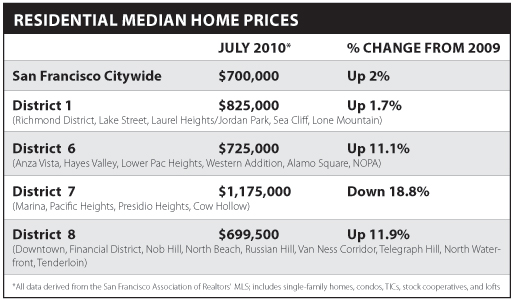Most all of us are familiar with the oft-quoted median price statistic – the amount paid for a property where half of the properties in the area sell for less and half sell for more. Newspapers, cable news outlets and Realtors like to quote median price as a way to gauge what is happening in the residential real estate market. Statisticians will tell you that median price is a better gauge than average price, as the statistic is less likely to be influenced by a fluke high (or low) sale. Normally, median price serves us well. In the past several years, however, there was a shift in the market, which made me question our ability to use median price the way we had in the past.

Imagine if overall sales volume was off 50 percent while the sales volume of property selling over $1.5 million was off almost 70 percent. This was San Francisco in early 2009 compared with the same period in 2008. With fewer high-end properties selling relative to their lesser-priced cousins, the necessary outcome was a drop in the median sales price – not because property values had declined, but due to the mix of properties selling. Now don’t get me wrong, I know prices declined throughout most of San Francisco, but not as much as the beloved “San Francisco median sales price” statistic would have us believe.
Fortunately for everyone, San Francisco residential sales volume year-to-date is up about 24 percent compared to 2009. Growth in the residential market for properties selling at $1.5 million and up has increased even more – over 30 percent. Deals are being made. Folks are downsizing as they send their kids off to college, or trading their condos for single family homes to accommodate the coming baby or to make room for the golden retriever. The market seems to be breathing once again.
So what do the median price numbers look like now? (See chart above.)
These figures are not accurate for any one property type and really do not tell a story that makes much sense. Of course, the same could be said for the “San Francisco” region statistics you see quoted in the news and in the Chronicle. The region defined often includes parts of the East Bay and/or Peninsula. At a glance, the reader assumes the data is relevant to San Francisco proper – not so.
So what is your property worth? Real estate is local; statistics like median price are not going to tell you. They could be telling you the general direction of the market, or be skewed by the mix of inventory included in generating the numbers. Most likely it’s a little of both. With statistics, asking the right question and defining what is included is key.
Stay tuned as we explore more inside tips and analysis in the months ahead. In the meantime, be sure to carefully read the fine print on any statistic presented for your consideration.
Matthew Borland is a managing broker and partner at Zephyr Real Estate and the past president of the San Francisco Association of Realtors. E-mail: matthew@zephyrsf.com








